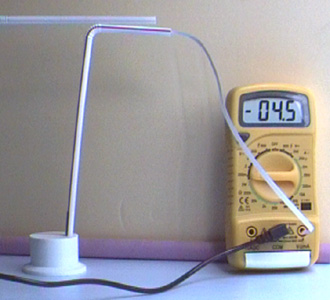Electrostatics experiments
by Michel Maussion - University of Nantes - France |
Several methods are possible to find the sign of the charge of an object :
In the former experiments it has been observed that the electroscope takes a charge like the one of the object if it is charged by contact or by points and an opposite one by induction. It has also been seen that a new object coming further near, has the same sign that the electroscope if the leaves begin to shut, and the opposite sign if they part more. So, knowing with certainty the charge of one object is enough to deduce that of all the others.
Get back the support and the paper of the previous experiment and get a cheap multimeter.
 |
|
Insert one end of the paper strip into the straw of the support and the other end into the born +. Leave the thread of the born - (COM) running on the table. |
![]()
![]()